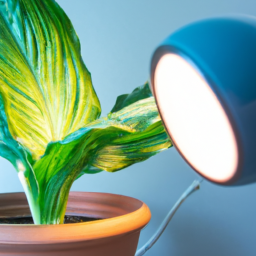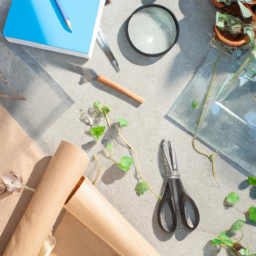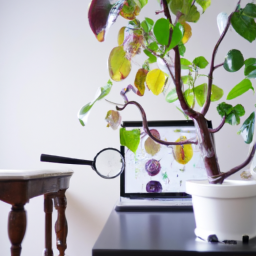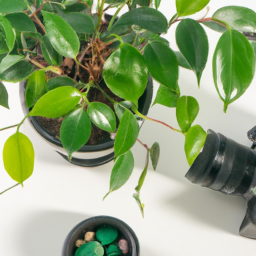
Are you a plant lover looking to create the perfect indoor oasis? If so, you’ve come to the right place! In this blog post, we’ll be discussing all the essential tips and tricks for setting up the ideal indoor plant environment. Whether you’re a seasoned plant enthusiast or just starting your green thumb journey, these tips for success will help you create a thriving and beautiful indoor garden. From choosing the right plants to creating the perfect lighting and humidity levels, we’ve got you covered. So, let’s dive in and learn how to create the ideal indoor plant environment!
Choosing the Right Lighting for Indoor Plants
Indoor plants can bring life and beauty to any space, but to ensure their success, it’s crucial to provide them with the right lighting. Light is essential for photosynthesis, the process by which plants convert light energy into food. When setting up your ideal indoor plant environment, consider the following tips to provide the perfect lighting conditions for your plants’ growth and well-being.
Understanding the Different Types of Light
Before diving into the specifics of lighting for indoor plants, it’s important to understand the different types of light. Natural light is the best source for plants, but when that’s not available, artificial light can be used as a substitute. There are three main types of artificial light that are commonly used for indoor plants:
1. Incandescent Lights: These lights are the least expensive option but are not ideal for plant growth. They produce a lot of heat and emit a red spectrum of light, which is not sufficient for most plants’ needs.
2. Fluorescent Lights: Fluorescent lights are a popular choice for indoor plants. They come in various types, including cool white, warm white, and full spectrum. Cool white lights provide a bluish light, which is suitable for foliage growth. Warm white lights emit a reddish spectrum, which is ideal for flowering plants. Full spectrum lights mimic natural sunlight and are the best choice for overall plant growth.
3. LED Lights: LED lights are becoming increasingly popular due to their energy efficiency and versatility. They come in a wide range of colors and can be customized to meet specific plant requirements. LED lights are more expensive upfront, but they last longer and consume less electricity in the long run.
Assessing Your Plant’s Lighting Needs
Now that you are familiar with the different types of light, it’s important to assess your plant’s specific lighting needs. Different plants have different light requirements, so it’s essential to understand what your plants need to thrive. Here are a few factors to consider:
1. Plant Species: Research the specific lighting requirements of the plants you have or plan to purchase. Some plants, like succulents, thrive in bright, direct light, while others, like ferns, prefer indirect, filtered light.
2. Light Intensity: The intensity of light needed varies depending on the plant species. High-light plants require bright, direct light, while low-light plants can tolerate lower light levels. Understanding the light intensity your plants need will help you choose the right lighting setup.
3. Light Duration: Most plants require a minimum of 6-8 hours of light per day. Some plants, like cacti, can tolerate longer periods of direct sunlight, while others, like orchids, prefer shorter durations of indirect light.
Setting Up Your Lighting System
Once you’ve determined your plant’s lighting needs, it’s time to set up your lighting system. Here’s a step-by-step guide to help you get started:
1. Choose the Right Bulbs: Select the appropriate type of bulbs based on your plant’s lighting requirements. Remember that fluorescent lights are a cost-effective option, while LED lights offer more customization.
2. Determine the Placement: Place your plants near windows where they can receive natural light. If natural light is limited, position your artificial lights above the plants, ensuring even coverage. Consider using reflective surfaces to maximize light distribution.
3. Set the Light Duration: Use a timer to ensure your plants receive the correct amount of light each day. Set the timer according to your plant’s specific lighting needs, adjusting as necessary.
4. Monitor and Adjust: Regularly monitor your plants’ response to the lighting system. If you notice signs of light deficiency, such as leggy growth or pale leaves, increase the light intensity or duration. Conversely, if your plants show signs of light burn, such as yellowing or wilting leaves, reduce the light intensity.
Remember, finding the right lighting setup for your indoor plants may require some experimentation and adjustments. By understanding your plants’ lighting needs and providing them with the right conditions, you’ll create an ideal indoor plant environment that promotes their growth and overall well-being.


Creating an Optimal Temperature Range for Indoor Plant Growth
When it comes to indoor plant care, providing the right temperature is crucial for their overall growth and well-being. Just like humans, plants have specific temperature preferences that allow them to thrive. In this guide, we will walk you through the steps of creating an ideal temperature range for your indoor plants, ensuring their success and longevity.
Understanding the Temperature Needs of Indoor Plants
Before diving into the specifics of setting up the ideal temperature range, it’s important to understand the temperature needs of indoor plants. Different plants have different temperature preferences, so it’s essential to choose plants that are suitable for the conditions you can provide.
Generally, most indoor plants thrive in temperatures between 60°F (15°C) and 75°F (24°C) during the day, and slightly cooler temperatures between 55°F (13°C) and 65°F (18°C) at night. However, it’s crucial to research the specific temperature requirements of the plants you have or plan to purchase, as some may have more specific needs.
Factors such as humidity, air circulation, and sunlight exposure can also influence the temperature requirements of indoor plants. It’s essential to consider these factors when creating an optimal temperature range.
Controlling Temperature for Indoor Plants
Now that you have a basic understanding of the temperature needs of indoor plants, let’s explore how to control the temperature within your indoor environment.
1. Placement: The placement of your indoor plants can greatly affect their temperature. Keep them away from drafty areas, such as windows and doors, as these can expose them to extreme temperature fluctuations. Additionally, avoid placing them near heat sources like radiators or air conditioning vents, as this can lead to overheating or drying out of the plants.
2. Heating and Cooling: Depending on your climate and the temperature requirements of your plants, you may need to provide additional heating or cooling. Consider using a thermostat-controlled space heater or a fan to regulate the temperature within the room. This will help maintain a consistent temperature range for your plants.
3. Humidity: Indoor plants often thrive in environments with moderate humidity levels. Increasing the humidity around your plants can help regulate the temperature and prevent them from drying out. You can achieve this by using a humidifier, placing a tray of water near the plants, or grouping plants together to create a microclimate with higher humidity.
Monitoring and Adjusting Temperature
Once you have set up the ideal temperature range for your indoor plants, it’s important to monitor and adjust it as needed. Here are some tips for effectively monitoring and adjusting the temperature:
1. Thermometer: Invest in a reliable thermometer to accurately measure the temperature within your indoor space. Place the thermometer near your plants to get an accurate reading of their immediate environment.
2. Regular Checks: Make it a habit to regularly check the temperature in the room where your plants are located. This will help you identify any fluctuations or inconsistencies that may need to be addressed.
3. Adjustments: If you notice that the temperature is consistently outside the optimal range for your plants, take the necessary steps to adjust it. This may involve repositioning the plants, adjusting heating or cooling devices, or modifying the humidity levels.
By actively monitoring and adjusting the temperature, you can ensure that your indoor plants are always in their ideal environment, promoting healthy growth and overall success.
Creating an optimal temperature range for indoor plant growth is a crucial step in their care. By understanding the temperature needs of your plants, controlling the temperature within your indoor environment, and regularly monitoring and adjusting as needed, you can provide the ideal conditions for your plants to thrive. Remember, each plant is unique, so it’s important to research and cater to their specific temperature preferences. With the right temperature range, your indoor plants will flourish and bring beauty and vitality to your home.
Summary Snapshot
Are you a plant lover looking to create the perfect indoor environment for your green friends? Look no further! In this blog post, we will share some valuable tips to help you set up the ideal indoor plant environment for success.
First and foremost, lighting is key. Most indoor plants thrive in bright, indirect light. Find a spot in your home that receives ample natural light throughout the day, but avoid placing your plants directly in the path of harsh, direct sunlight. If your space lacks natural light, you can also invest in artificial grow lights that mimic the sun’s rays. Remember to adjust the lighting duration based on the specific needs of your plants, as some may require more or less light exposure.
Next, let’s talk about temperature and humidity. Most indoor plants prefer temperatures between 60 and 75 degrees Fahrenheit, so it’s important to keep them away from drafts or extreme temperature fluctuations. Additionally, many plants thrive in environments with higher humidity levels. You can increase humidity by placing a tray of water near your plants or using a humidifier. Regularly misting your plants with water can also help maintain the ideal humidity levels.
Lastly, don’t forget about proper watering and fertilizing. Overwatering is one of the most common mistakes that plant owners make. Before watering, check the moisture level of the soil by inserting your finger about an inch deep. If it feels dry, it’s time to water. However, if it’s still moist, hold off on watering for a few more days. Additionally, remember to fertilize your plants regularly using a balanced fertilizer to provide them with the necessary nutrients for growth.
By following these tips, you’ll be well on your way to creating the perfect indoor plant environment. Remember, each plant is unique, so it’s essential to understand its specific needs. With a little patience and care, your indoor plants will flourish and bring life and beauty to your home.
Let me leave you with some FAQs:
Q1: What are the key factors to consider when setting up the ideal indoor plant environment?
A1: When setting up the ideal indoor plant environment, there are a few key factors to consider. First, you need to determine the amount of light your plants require. Some plants thrive in bright, direct sunlight, while others prefer indirect or low light conditions. Secondly, consider the temperature and humidity levels in your home. Most indoor plants prefer temperatures between 60-75°F (15-24°C) and humidity levels of around 40-60%. Additionally, ensure proper air circulation and ventilation to prevent stagnant air. Finally, choose the right soil and pot for your plants, providing adequate drainage to avoid waterlogging.
Q2: How can I provide sufficient light for my indoor plants?
A2: To provide sufficient light for your indoor plants, place them near windows that receive bright, indirect sunlight. South-facing windows usually offer the most light, while east and west-facing windows provide moderate light. If your home lacks natural light, you can use artificial grow lights. LED grow lights are a popular choice as they are energy-efficient and emit the right spectrum of light for plant growth. Position the lights about 12-18 inches above the plants and keep them on for around 12-16 hours a day.
Q3: What can I do to maintain proper temperature and humidity levels for my indoor plants?
A3: To maintain proper temperature and humidity levels for your indoor plants, keep them away from drafts and extreme temperature fluctuations caused by heating or cooling systems. Use a thermometer and hygrometer to monitor the temperature and humidity in the room. If the air is too dry, especially during winter months, you can increase humidity by placing a tray filled with water near the plants or using a humidifier. If the air is too humid, ensure good air circulation and avoid overwatering to prevent mold or fungal growth.
Q4: How important is air circulation for indoor plants, and how can I ensure it?
A4: Air circulation is crucial for indoor plants as it helps prevent the buildup of stagnant air and reduces the risk of pests and diseases. To ensure adequate air circulation, avoid crowding plants too closely together. Leave some space between them to allow for proper airflow. You can also use a small fan set on low speed to gently circulate the air around your plants. Just make sure the fan is not blowing directly on the plants, as it may cause damage.
Q5: What type of soil and pots should I use for my indoor plants?
A5: When choosing soil for your indoor plants, opt for a well-draining potting mix specifically designed for indoor plants. These mixes usually contain a blend of peat moss, perlite, and vermiculite, which provide good drainage while retaining enough moisture. Avoid using garden soil, as it tends to be too heavy and may not drain properly. As for pots, select containers with drainage holes to allow excess water to escape. This prevents waterlogging and helps maintain the ideal moisture level for your plants’ roots.
Dr. Olivia Green is a botanist with over two decades of experience in indoor plant cultivation. She holds a Ph.D. in Plant Biology and has dedicated her career to researching plant behavior in controlled environments. Dr. Green is passionate about helping plant enthusiasts master the art of indoor gardening through her extensive knowledge and practical insights.


